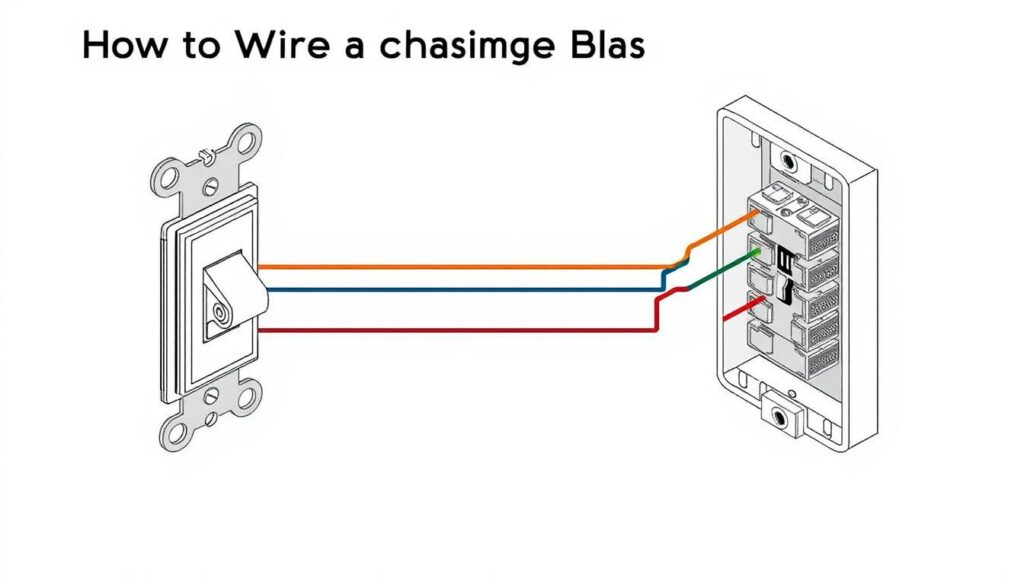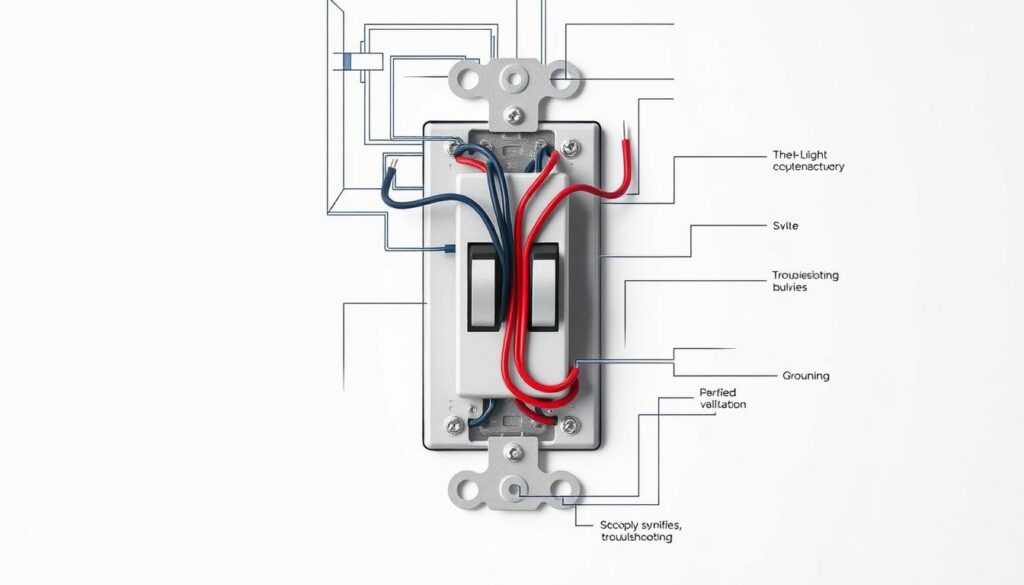Light Switch Wiring Diagram: Easy Guide with Diagrams
Table of Contents
Understanding a light switch wiring diagram is key to safe and efficient home electrical projects. Whether replacing or installing a switch, a clear wiring a light switch diagram ensures proper operation. This guide breaks down switch light switch diagrams with step-by-step instructions, making wiring easy for all skill levels. Follow these tips to master wiring a light switch diagram with confidence!
Every time you flip a light switch wiring diagram, electricity flows through precise connections. This includes brass terminals, black wires, and safety checks. This guide turns confusion into clarity, using wiring a light switch diagram steps anyone can follow.
Imagine replacing a switch yourself, saving up to $150 in labor costs. From single-pole basics to three-way setups, this guide covers it all. Learn to spot hazards like scorch marks or loose wires before they become bigger issues with a reliable light switch wiring diagram.
Key Takeaways
- Use light switch wiring diagrams to identify hot and load wires correctly.
- Single-pole switches form 70% of home switches but require proper grounding to avoid overheating.
- Diagrams simplify three-way and four-way setups for hallways or large rooms.
- 90% of dimmer switches come pre-wired, making upgrades easier with this guide’s steps.
- Check local codes—50% of areas allow repurposed white wires, but mistakes risk safety.
Understanding Light Switch Wiring Basics
Learning about light switch wiring diagrams begins with understanding how electricity moves through circuits. A wiring a light switch diagram makes this easier by showing each step clearly. Always refer to a switch light switch diagram to ensure proper connections and safety. Before starting work on wires, always turn off the power at the circuit breaker to prevent electrical hazards. Using a light switch wiring diagram will help you follow the correct process and complete your installation with confidence.
What Happens Inside a Light Switch
A single-pole switch works like a drawbridge, controlling the flow of electricity. It has two brass screws for black wires, which carry the power. When you flip the switch, electricity goes to the light fixture. The switch light switch diagram shows this path clearly.
Leviton switches, for example, use red wires as hot lines in 30% of their setups.
The Role of Circuit Breakers
- Breakers protect circuits by cutting power during overloads or shorts
- Always turn off the corresponding breaker before wiring
- 30% of electrical accidents stem from neglecting this step
Use a voltage tester to ensure safety—70% of DIYers forget this, risking injury. Safety stats show 40% of electrician calls are due to bad wiring. So, double-check your wiring diagram of a light switch to match your connections.
Common Wiring Color Codes in the US
Follow standard U.S. color conventions:
| Color | Type | Purpose |
|---|---|---|
| Black | Hot | Power source to the switch |
| White | Neutral | Returns current to the panel |
| Green/Bare Copper | Ground | Safety path for fault currents |
Red wires often carry power in 50% of three-way setups. Always check your switch light switch diagram to avoid mistakes.
Essential Safety Precautions Before You Begin
Before starting any wiring project, safety is key. Over 50% of DIY electrical work risks come from ignoring basic precautions. Always turn off the power at the circuit breaker, not just the wall switch. Make sure to label the breaker to avoid turning it back on by mistake.
Use a non-contact voltage tester to check for electricity. This step can reduce electrocution risks by 90%. Always wear insulated gloves and use tools with rubber grips. Make sure your work area is dry, as water and electricity are dangerous together.
- Turn off power at the breaker and lock it if possible
- Test wires with a voltage detector before handling
- Use insulated tools and gloves
- Ensure workspace is dry and well-ventilated
- Label all wires using color-coded tape for reference
Electrical failures cause 13% of home fires, according to the National Fire Protection Association.
Check local codes before starting. Many places need GFCI outlets near sinks or outdoors. If you’re unsure about the wiring, look at the NEC guidelines. Keep a phone nearby and have someone ready to help.
Professional electricians cost $100–$200 for simple switches but are crucial for complex jobs. Never skip grounding wires or take shortcuts with wire connections. Incorrect connections can cause fires. If you’re unsure, stop and get help. Safety is the base of every electrical project.
Tools and Materials Needed for Light Switch Installation
Every light switch project needs the right tools and materials for safety and proper installation. Use light switch wiring diagrams to pick the correct parts. Without the right tools or materials, you might face hazards or failed connections.
Required Tools Checklist
Here are the basics:
- 4-in-1 screwdriver (flathead/Phillips)
- Non-contact voltage tester (to check live wires)
- Utility knife (cutting sheathing on cables)
- Wire strippers (precise insulation removal)
- Electrical tape (insulating connections)
Wire Types and Gauges
Choose wires based on circuit amperage:
- 14-gauge NM-B cables (15A circuits, 14-2 or 14-3 for multi-switch setups)
- Copper pigtails (connecting switch terminals)
- Wire nuts (secure wire splices)
Optional Accessories
Consider these extras:
- Wire labels (prevent connection mix-ups)
- Fish tape (pulling wires through walls)
- Insulated gloves (added safety layer)
Check light switch wiring diagrams for compatibility. Make sure all tools work and materials meet local codes before starting.
Types of Light Switches and Their Wiring Requirements
Choosing the right light switch depends on your space and control needs. Each type has unique wiring steps outlined in wiring a light switch diagram guides. Start by identifying which option suits your setup.
Single-Pole Switch Wiring
Single-pole switches control lights from one location. They use three terminals: LINE-IN (power source), LINE-OUT (to the light), and ground. Look for diagrams labeled light switch wiring diagram for single-pole setups. For example, a bedroom light controlled by one switch uses this basic configuration. IGOTO Electric offers durable single-pole models with 15-amp ratings for standard homes.
Three-Way Switch Configurations
Three-way switches let you toggle lights from two spots, like a staircase. They require a common terminal (hot line), traveler wires (red/white), and ground. NEC codes mandate grounding in metal boxes. A hallway’s two-end control needs two three-way switches connected via traveler wires. Diagrams clarify which terminal connects to the incoming power.
Four-Way Switch Setups
Add a four-way switch between two three-ways to control lights from three+ locations. These switches reroute traveler wires between pairs. For example, a long hallway might use one four-way between two three-ways. Always follow manufacturer instructions when expanding circuits beyond two locations.
Dimmer Switch Wiring Considerations
Dimmers need compatible bulbs (LED/CFL) and often include pre-attached wires. Their wiring matches single-pole setups but require checking load limits (e.g., 600W max for many dimmers). Always refer to the manufacturer’s wiring a light switch diagram for dimmer specifics.
Smart Switch Installation Differences
Smart switches like those from IGOTO require neutral wires and sometimes a hub for remote access. Their wiring adds data lines for Wi-Fi/Bluetooth connectivity. Always turn off power at the breaker before installing and follow the included light switch wiring diagram for neutral wire placement.
Step-by-Step Light Switch Wiring Diagram Guide
Electrical diagrams make complex connections easier. wiring diagram of a light switch uses symbols like circles (switches), rectangles (outlets), and lines (wires). Knowing these symbols helps avoid mistakes.
- Black lines = hot wires
- White lines = neutral wires
- Green or bare copper = ground wires
| Configuration | Power Path | Wiring Notes |
|---|---|---|
| Power-Through | Power enters switch first | Use black/red travelers for three-way setups |
| End-Line | Power enters fixture first | Neutral wires must be spliced in this setup |
IGOTO Electric’s switch light switch diagram tools make wiring easier. Their three-way switches use tested traveler wires for 20A circuits. Always match wire colors to terminal labels: black to brass, white to silver, green to ground screws. For smart switches, check if a neutral wire is present—20% of homes might not have one, according to industry data.
Common mistakes include mixing traveler wires or skipping ground connections. Misplaced wires in four-way setups can disable multi-switch control. Refer to manufacturer guides like IGOTO’s 15-year warranty documentation for diagrams. Their three-way wiring needs a common terminal (black wire) and two traveler terminals (red wires) to work right.
How to Wire a Single-Pole Light Switch
Following a wiring schematic for light switch ensures safe installation. Start by turning off power at the circuit breaker. Use a voltage tester to confirm wires are inactive before touching any components. This guide uses standard U.S. color codes: black for live wires, white for neutral, and green/bare copper for grounding.

Begin by identifying line (power source) and load (light fixture) wires. In a two-wire setup, the black line wire connects to the switch’s “line” terminal. The load wire (often black) goes to the “load” terminal. If using a three-wire cable, the white wire may act as a hot wire when marked with black tape. Always connect ground wires first—twist the bare copper wire to the switch’s green terminal and secure it to the box’s grounding screw.
When securing the switch, fold wires neatly into the electrical box. Mount the switch so the toggle faces downward when off—this aligns with safety standards. Tighten screws firmly but avoid over-tightening, which can damage terminals. Test the setup with the breaker on, using a voltage tester at both terminals to ensure proper function. If the switch behaves unpredictably, double-check connections against a light switch wiring diagrams reference.
Always disconnect power before handling wires—even brief interruptions can be dangerous.
Ensure all wires are tucked behind the switch plate. Final checks include flipping the switch to confirm the light responds correctly. For dimmer compatibility, verify bulb types match the switch’s specifications to avoid flickering or damage.
Three-Way Switch Wiring: Complete Instructions
Learning to wire a light switch diagram for three-way systems begins with knowing about traveler wires. These switches have three terminals: a common (dark screw), two travelers (brass), and a ground. Unlike a standard switch light switch diagram, three-way setups need two switches connected by traveler wires for control from both sides.
| Terminal | Wire Color | Purpose |
|---|---|---|
| Common (COM) | Black | Connects to power source or light fixture |
| Traveler 1 | Red | Pathway 1 for electrical flow |
| Traveler 2 | Black | Pathway 2 for dual-control functionality |
| Ground | Bare Copper | Secures to grounding screw |
- Turn off circuit breaker and test wires with a voltage tester.
- Attach the common terminal to the incoming hot wire (black) or light fixture.
- Connect traveler wires (red/black) to brass terminals on both switches.
- Secure all ground wires to green or bare screw terminals.
Always use 14/2 or 12/2 cables for power feeds and 14/3 or 12/3 cables between switches per NEC standards.
Configuring the circuit: switch light switch diagram layouts change based on where power starts. If power comes in at the first switch, connect common to black, travelers to brass. For switches in the middle, use traveler wires between them. Always test connections with a continuity tester before turning power back on.
- Use red electrical tape on white wires repurposed as travelers
- Verify voltage at all terminals post-installation
- Replace ungrounded switches immediately
Wrong wiring can make lights act strangely—only working from one switch. Double-check traveler connections and terminal placements. Look at manufacturer diagrams for specific models. Always put safety first: 3-way systems need precise wire pairing to work right.
Troubleshooting Common Light Switch Wiring Problems
Electrical issues with light switches often signal deeper problems. Before diving into fixes, always turn off power at the breaker. Refer to a light switch wiring diagram to trace connections safely. Over 50% of home electrical fires start with faulty wiring or lighting, per FEMA—so address issues promptly.

Switch Works Intermittently
- Loose terminal screws or corroded wires cause flickering lights.
- Recheck connections using the wiring diagram of a light switch for proper traveler/brass screw placement.
- Replace cracked switch plates to avoid mechanical stress.
Light Stays On Regardless of Switch Position
Incorrect line/load wire identification can create a live circuit. Verify wiring paths using a continuity tester. Ensure no accidental short circuits between terminals—cross-referencing your setup with light switch wiring diagrams helps spot errors.
Buzzing or Humming Sounds
Incompatible dimmer switches with bulb types cause vibrations. Loose wire nuts or damaged switches also produce noise. Tighten connections and test for voltage using a multimeter. Persistent sounds warrant professional inspection.
Warm or Hot Switch Plate
A hot switch plate signals overheating—a fire risk. Check for loose wires or overloaded circuits. If the switch reaches unsafe temperatures, replace it immediately. Overheating costs Southern California residents $50-$150 in emergency repairs if ignored.
DIY fixes save time, but safety comes first. If troubleshooting reveals complex issues, contact licensed electricians like Express Electrical for 90-minute emergency response. Always prioritize certified wiring practices to avoid electrical shock or fire risks.
Meeting Electrical Code Requirements for Switch Installation
Following electrical codes is key for safe and legal installations. Use the right wiringing schematic for light switch and a light switch wiring diagram to stay within the law. Knowing the rules is the first step to safety.
National Electrical Code Guidelines
The National Electrical Code (NEC) outlines the minimum standards. Important rules include:
| Requirement | Details |
|---|---|
| Wire Marking | White wires used as hot must have black tape or paint at both ends |
| Circuit Ratings | 15A circuits use 14-gauge wire; 20A require 12-gauge |
| Grounding | All devices must connect to a ground wire or metal box |
NEC 2023 updates require lockable disconnects for air conditioners. Kitchen circuits need AFCI protection on all lighting and outlets.
Local Code Variations
Local rules might add extra requirements like thicker conduit in coastal areas or more GFCI outlets. Always check with your local building department before starting.
Permit Requirements
Over 75% of homeowners hire pros for complex electrical work due to code complexity.
Most electrical changes need a permit. Without one, insurance policies might not cover your work. DIY projects often miss codes, risking fines or safety hazards.
Key Compliance Tips
- Verify local amendments to NEC standards
- Use certified wiring schematics from trusted sources
- Always secure a permit for new installations
Ignoring codes can lead to safety and legal problems. Getting professional advice ensures you meet all regulations.
When to Call a Professional Electrician
Even with a wiring schematic for light switch or wiring a light switch diagram, some tasks demand expert help. Knowing when to call a licensed electrician protects your home and safety. Over 70% of homeowners face confusion with complex setups like phantom switches or outdated systems. Here’s when to prioritize professional assistance.
- Encountering aluminum wiring or knob-and-tube systems
- Working with high-voltage circuits (e.g., 240V setups)
- Modifying circuits or adding new wiring paths
- Fixing persistent issues after checking a wiring diagram
- Upgrading electrical panels or outdated systems
| Scenario | DIY Option | Professional Required |
|---|---|---|
| Replacing a single switch | Yes (if experienced) | No |
| Aluminum wiring | No | Yes |
| 3-way or 4-way switches | Risk of errors | Recommended |
| Code compliance checks | No | Yes |
Professional electricians cost $50–$150 for standard jobs. DIY mistakes risk 80% of electrical incidents, including fire hazards or voided insurance. Always verify an electrician’s license and insurance. Avoid shortcuts—modern codes require ground wires in new installations. Smart switches, while user-friendly, may still need expert setup for full functionality.
For complex setups like 3-way configurations or outdated wiring, a pro ensures safety and code adherence. Prioritize safety over cost savings—electrical errors can lead to costly repairs or legal liabilities.
Conclusion: Safely Completing Your Light Switch Wiring Project
Before finishing, check the light switch wiring diagram to make sure all connections are correct. Ensure all wire connections are tight and securely placed inside the box. Then, mount the switch firmly and attach the faceplate to complete the job. Always refer to the wiring a light switch diagram to verify proper installation.
Turn on the circuit breaker and test the switch. Flip it on and off multiple times to confirm it works correctly. If issues arise, turn off the breaker and double-check the connections using the switch light switch diagram. Always make sure power is off before making any adjustments.
Follow the National Electrical Code, especially for three-way or four-way switches. Use NM-B Romex for single-pole setups and 12/3 or 14/3 Romex for dual-control systems. Always refer to a light switch wiring diagram to ensure compliance and safety. Treat all wires as live until properly tested.
Take photos of your wiring before closing the box—this can assist with troubleshooting later, such as fixing flickering lights or loose switches. Regular inspections following a wiring a light switch diagram can help prevent hazards like overheating plates.
Remember, safety measures like using tamper-resistant designs and proper grounding are crucial. If unsure about complex setups like three-way systems, seek help from a licensed electrician. Following these steps and using a light switch wiring diagram ensures your work is safe, reliable, and meets 2023 NEC standards.

